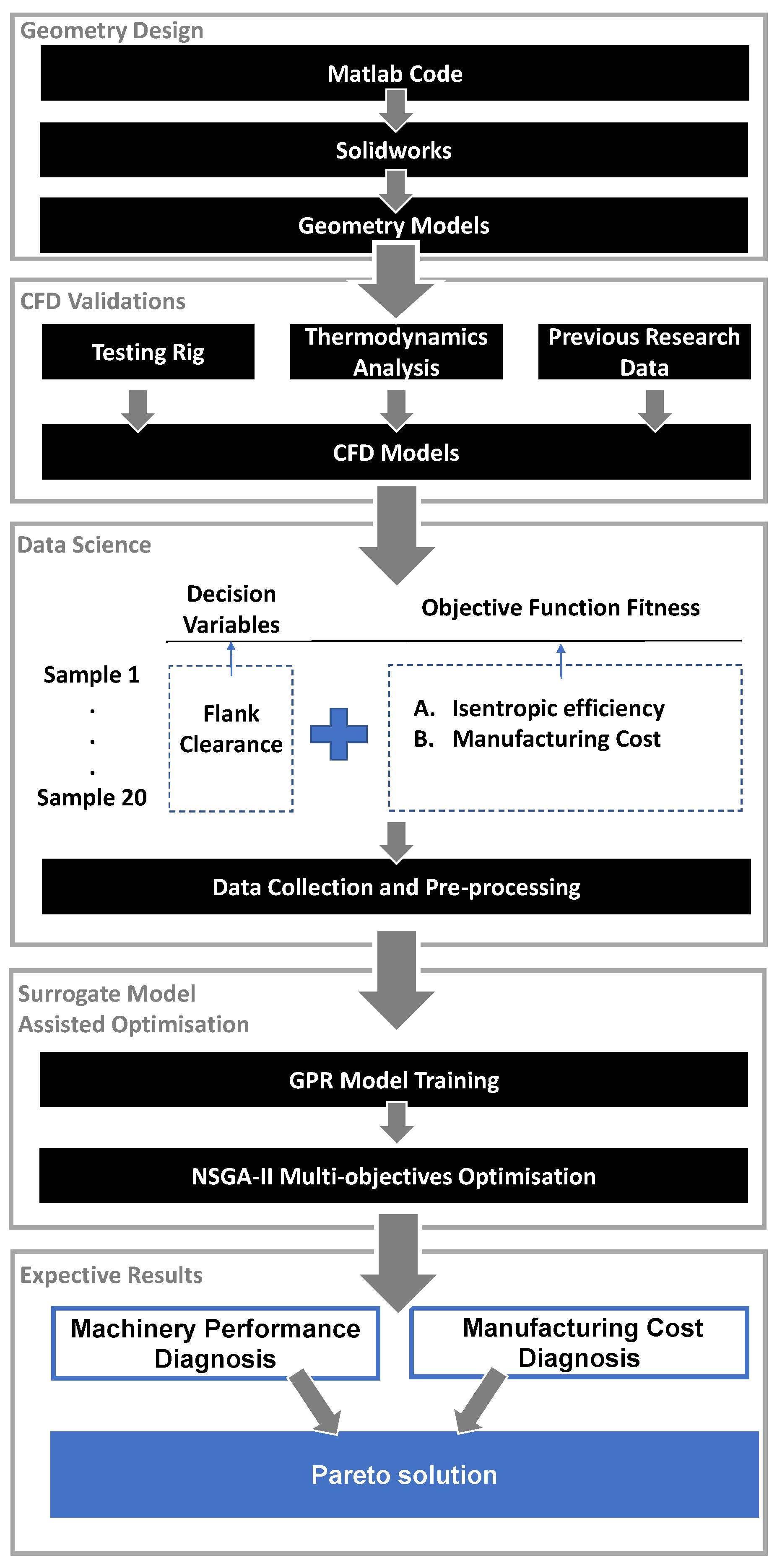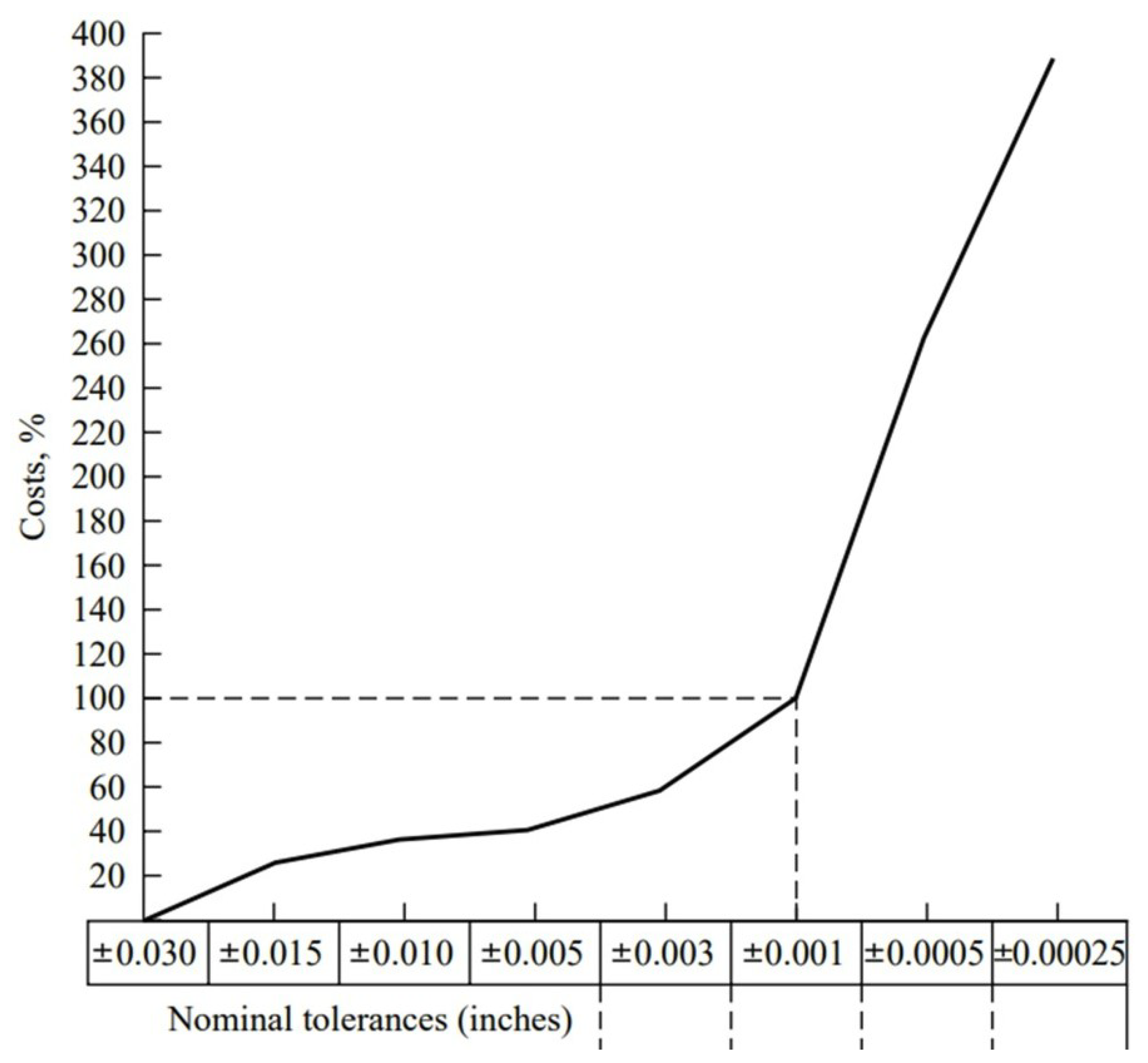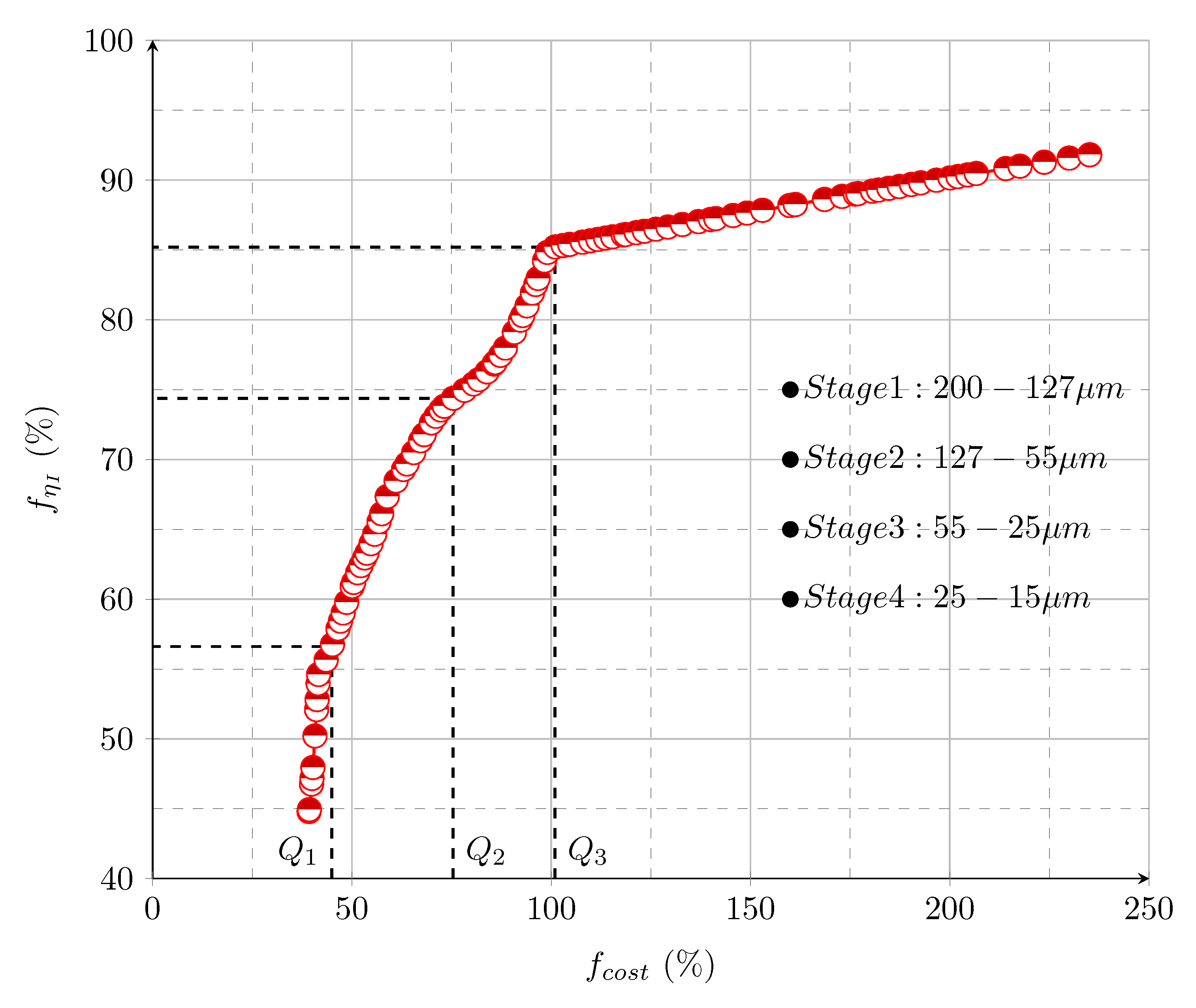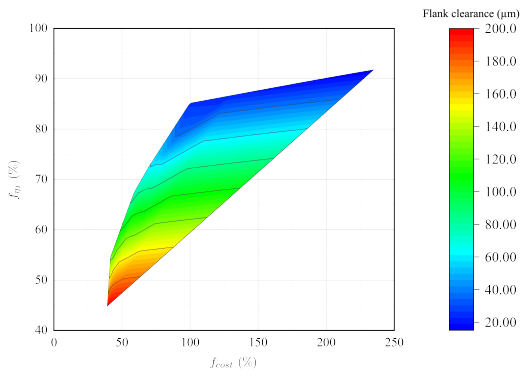Surrogate-Assisted Multi-Objective Optimisation of Transcritical Carbon Dioxide Scroll Expander Flank Clearance Based on Computational Fluid Dynamics
Abstract
:1. Introduction
- Evaluate the thermodynamic performance (first law) of different flank clearances on a T-CO2 scroll expander.
- Build a GPR model to surrogate the relationship between the size of the flank clearance and the scroll expander efficiency and apply the NSGA-II to optimise the clearance manufacturing cost and the scroll expander efficiency that is predicted by GPR.
- Build a piecewise polynomial regression model to represent the trade-off relationship between the scroll expander efficiency and clearance manufacturing cost.
2. Methodology
2.1. Geometry Design
2.2. CFD Design
2.3. Surrogate-Assisted Multi-Objective Optimisation
2.3.1. Multi-Objective Optimisation Problem Definition

2.3.2. Objective Function Definitions for
2.3.3. Objective Function Definitions for
2.3.4. Multi-Objective Optimisation
- Step 1: Initialize a population of solutions .
- Step 2: Use crossover and mutation to generate a population of offspring from .
- Step 3: Use non-dominated sorting to divide into several non-domination fronts
- Step 4: Starting from , solutions are stored in a temporary archive till its size for the first time equals or exceeds N, where . In particular, is the last acceptable non-domination front. If the size of equals N, then let and go to Step 6; otherwise go to Step 5.
- Step 5: Calculate the crowding distance of solutions in and sort them in a descending order. Remove the last solutions from and let .
- Step 6: If the stopping criterion is met, then stop and output ; otherwise, go to Step 2.
3. Results and Discussion
3.1. First Law of Thermodynamics Analysis
3.2. Pareto-Optimal Front
3.2.1. Pareto-Optimal Front Confidence Interval and Validations
3.2.2. Pareto-Optimal Front Results
4. Conclusions
- For thermodynamic analysis, the flank clearance made a significant impact on the isentropic efficiency. The isentropic efficiency dropped from 87.41% to 44.83%, with the increase in flank clearance from 20 to 200 µm. Although the isentropic efficiency decreased, the power output rate increased to 1.18 due to the mass flux rate rising to 2.31. The flank clearance has a significant negative impact on the performance of the machinery, and it is a critical point that needs to be solved.
- The SAMO (GP) algorithm contributes a final Pareto-optimal front considering the two objectives. The area between the upper and lower bounds represents all the potential solutions. The final Pareto-optimal front using the mean value provided the trade-off solutions between the two objectives. It also indicated that flank clearances from 127 to 200 µm have the most potential for the sealing design.
- The SAMO (GP) was successfully applied to the T-CO2 scroll expander transient dynamic mesh CFD model. It significantly reduced the computational cost, from 90 h to 15 s, and showed consistent reliability. For the development of expander or similar machinery CFD simulations, this methodology can be applied to speed up the calculations and also consider more objectives. For the development of an optimisation algorithm, learning to optimise by using synthetic data could be a future direction. For example, given two objective functions, if the evaluation cost of one is much cheaper than the other and the trade-off relationship between them can be used as prior knowledge, it is possible to evaluate the cheaper objective function to obtain training data and try to train a generative model based on the trade-off relationship to generate synthetic data for the more expensive objective function.
Author Contributions
Funding
Data Availability Statement
Conflicts of Interest
Nomenclature
| Acronyms/Abbreviations | |
| ANNs | Artificial Neural Networks |
| CFD | Computational Fluid Dynamics |
| DIP | Dual Intake Port |
| EMO | Evolutionary Multi-objective Optimisation |
| GPR | Gaussian Process Regression |
| IBEA | Indicator Based EA |
| KE | Kinetic Energy |
| MOEA/D | Multi-objective EA Based on Decomposition EA |
| NSGA-II | Non-dominated Sorting Genetic Algorithm |
| ORC | Organic Rankine Cycle |
| PE | Potential Energy |
| PF | Pareto-optimal Front |
| POD | Probability of Detection |
| RNG | Re-normalisation Group |
| S-CO2 | Supercritical Carbon Dioxide Cycle |
| SAMOA | Surrogate-assisted Multi-objective Optimisation Algorithm |
| SIMPLEC | Semi-implicit Method for Pressure Linked Equations Consistent |
| SVR | Support Vector Regression |
| T-CO2 | Transcritical Carbon Dioxide Cycle |
| URANS | Unsteady Reynold’s-averaged Navier–Stokes Equations |
| Greek Symbols | |
| Efficiency (%) | |
| Involute angle (rad) | |
| h | Enthalpy (kJ/kg) |
| Roman Symbols | |
| Flank clearance (mm) | |
| h | Height (mm) |
| m | Mass per revolution (kg) |
| Q | Heat (J) |
| Base circle radius (mm) | |
| Design ratio (-) | |
| t | Time (s) |
| th | Thickness (mm) |
| U | Internal energy (J) |
| W | Watt (W) |
| Subscripts | |
| 1 | Start point of rotating |
| 2 | End point of rotating |
| end | Ending state of involute |
| h | Work done by enthalpy |
| i0 | Initial state of inner involute |
| I | First law |
| ideal | Work done by ideal process |
| in | Inlet |
| is | Starting state of inner involute |
| o0 | Initial state of outer involute |
| os | Starting state of outer involute |
| out | Outlet |
| t | Total enthalpy |
Appendix A. ICEM Mesh to .CDB File
- Open ANSYS Workbench.
- Select Static Structural in Analysis Systems.
- Select ICEM CFD in the Component Systems.
- Connect the ICEM CFD to the Model component in the Static Structural.
- Generate mesh in ICEM CFD.
- Open Model in Static Structural.
- Create name selection to the mesh domain, e.g., body1.
- Click Commands (APDL) and insert following commands:/PREP7cmsel,s,body1cdwrite,db,mesh_body1,cdbALLSEL/SOLUTION/EOF
- Click solve
- Right click solutions and open solver files directory. The .cdb file would be generated here.
Appendix B. Polynomial Equation Parameters
| Parameter | Stage 1 | Stage 2 | Stage 3 | Stage 4 |
|---|---|---|---|---|
| p1 | 0.005439 | −2.193 × 10 | 4.108 × 10 | 0.0004951 |
| (0.004764, 0.006114) | (−3.59 × 10, −7.963 × 10) | (3.32 × 10, 4.896 × 10) | (0.0004932, 0.0004971) | |
| p2 | −0.3984 | 0.0002961 | −0.0009216 | 0.8024 |
| (−0.4529, −0.344) | (6.003 × 10, 0.0005322) | (−0.001123, −0.0007201) | (0.8021, 0.8027) | |
| p3 | 7.708 | −0.005686 | 0.07097 | - |
| (6.611, 8.805) | (−0.01883, 0.007456) | (0.05386, 0.08808) | - | |
| p4 | - | 0.4251 | −1.13 | - |
| - | (0.1841, 0.6661) | (−1.611, −0.6481) | - | |
| SSE | 1.355 × 10 | 7.108 × 10 | 5.351 × 10 | 2.873 × 10 |
| R-squared | 0.9999 | 0.9991 | 0.9997 | 0.9998 |
| Adjusted R-squared | 0.9998 | 0.9989 | 0.9997 | 0.9998 |
| RMSE | 0.00044 | 0.001797 | 0.0005973 | 0.0002615 |
References
- Emhardt, S.; Tian, G.; Chew, J. A review of scroll expander geometries and their performance. Appl. Therm. Eng. 2018, 141, 1020–1034. [Google Scholar] [CrossRef]
- Song, P.; Wei, M.; Shi, L.; Danish, S.N.; Ma, C. A review of scroll expanders for organic Rankine cycle systems. Appl. Therm. Eng. 2015, 75, 54–64. [Google Scholar] [CrossRef]
- Guo, J.Q.; Li, M.J.; He, Y.L.; Jiang, T.; Ma, T.; Xu, J.L.; Cao, F. A systematic review of supercritical carbon dioxide (S-CO2) power cycle for energy industries: Technologies, key issues, and potential prospects. Energy Convers. Manag. 2022, 258, 115437. [Google Scholar] [CrossRef]
- Crespi, F.; Gavagnin, G.; Sánchez, D.; Martínez, G.S. Supercritical carbon dioxide cycles for power generation: A review. Appl. Energy 2017, 195, 152–183. [Google Scholar] [CrossRef]
- Du, Y.; Tian, G.; Pekris, M. A comprehensive review of micro-scale expanders for carbon dioxide related power and refrigeration cycles. Appl. Therm. Eng. 2022, 201, 117722. [Google Scholar] [CrossRef]
- Chen, Y.; Halm, N.P.; Groll, E.A.; Braun, J.E. Mathematical modeling of scroll compressors—Part I: Compression process modeling. Int. J. Refrig. 2002, 25, 731–750. [Google Scholar] [CrossRef]
- Iglesias, A.; Favrat, D. Innovative isothermal oil-free co-rotating scroll compressor—Expander for energy storage with first expander tests. Energy Convers. Manag. 2014, 85, 565–572. [Google Scholar] [CrossRef]
- Song, P.; Wei, M.; Zhang, Y.; Sun, L.; Emhardt, S.; Zhuge, W. The impact of a bilateral symmetric discharge structure on the performance of a scroll expander for ORC power generation system. Energy 2018, 158, 458–470. [Google Scholar] [CrossRef]
- Fatigati, F.; Di Giovine, G.; Cipollone, R. Feasibility Assessment of a Dual Intake-Port Scroll Expander Operating in an ORC-Based Power Unit. Energies 2022, 15, 770. [Google Scholar] [CrossRef]
- Emhardt, S.; Tian, G.; Song, P.; Chew, J.; Wei, M. CFD modelling of small scale ORC scroll expanders using variable wall thicknesses. Energy 2020, 199, 117399. [Google Scholar] [CrossRef] [Green Version]
- Emhardt, S.; Tian, G.; Song, P.; Chew, J.; Wei, M. CFD analysis of the influence of variable wall thickness on the aerodynamic performance of small scale ORC scroll expanders. Energy 2022, 244, 122586. [Google Scholar] [CrossRef]
- Rak, J.; Pietrowicz, S. Internal flow field and heat transfer investigation inside the working chamber of a scroll compressor. Energy 2020, 202, 117700. [Google Scholar] [CrossRef]
- Zheng, S.; Wei, M.; Song, P.; Hu, C.; Tian, R. Thermodynamics and flow unsteadiness analysis of trans-critical CO2 in a scroll compressor for mobile heat pump air-conditioning system. Appl. Therm. Eng. 2020, 175, 115368. [Google Scholar] [CrossRef]
- Zheng, S.; Wei, M.; Hu, C.; Song, P.; Tian, R.; Li, Y.; Sun, J.; Wu, D. Impact of micro-grooves in scroll wrap tips on the performance of a trans-critical CO2 scroll compressor. Int. J. Refrig. 2021, 131, 493–504. [Google Scholar] [CrossRef]
- Zheng, S.; Wei, M.; Zhou, Y.; Hu, C.; Song, P. Tangential leakage flow control with seal-grooves on the static scroll of a CO2 scroll compressor. Appl. Therm. Eng. 2022, 208, 118213. [Google Scholar] [CrossRef]
- Scallan, P.G. 9—Economics of process planning. In Process Planning; Butterworth-Heinemann: Oxford, UK, 2003. [Google Scholar]
- Jin, Y.; Wang, H.; Sun, C. Data-Driven Evolutionary Optimization; Springer: Berlin/Heidelberg, Germany, 2021. [Google Scholar]
- Bekiloğlu, H.E.; Bedir, H.; Anlaş, G. Multi-objective optimization of ORC parameters and selection of working fluid using preliminary radial inflow turbine design. Energy Convers. Manag. 2019, 183, 833–847. [Google Scholar] [CrossRef]
- Li, P.; Mei, Z.; Han, Z.; Jia, X.; Zhu, L.; Wang, S. Multi-objective optimization and improved analysis of an organic Rankine cycle coupled with the dynamic turbine efficiency model. Appl. Therm. Eng. 2019, 150, 912–922. [Google Scholar] [CrossRef]
- Xia, W.; Zhang, Y.; Yu, H.; Han, Z.; Dai, Y. Aerodynamic design and multi-dimensional performance optimization of supercritical CO2 centrifugal compressor. Energy Convers. Manag. 2021, 248, 114810. [Google Scholar] [CrossRef]
- Jin, Y.; Wang, H.; Chugh, T.; Guo, D.; Miettinen, K. Data-driven evolutionary optimization: An overview and case studies. IEEE Trans. Evol. Comput. 2018, 23, 442–458. [Google Scholar] [CrossRef]
- Athavale, J.; Yoda, M.; Joshi, Y. Comparison of data driven modeling approaches for temperature prediction in data centers. Int. J. Heat Mass Transf. 2019, 135, 1039–1052. [Google Scholar] [CrossRef]
- Duan, Y.; Cooling, C.; Ahn, J.S.; Jackson, C.; Flint, A.; Eaton, M.D.; Bluck, M.J. Using a Gaussian process regression inspired method to measure agreement between the experiment and CFD simulations. Int. J. Heat Fluid Flow 2019, 80, 108497. [Google Scholar] [CrossRef]
- Ringstad, K.E.; Banasiak, K.; Ervik, Å.; Hafner, A. Machine learning and CFD for mapping and optimization of CO2 ejectors. Appl. Therm. Eng. 2021, 199, 117604. [Google Scholar] [CrossRef]
- Du, Y.; Tian, G.; Pekris, M. Unsteady and three-dimensional computational fluid dynamics modelling of scroll expander for low-grade waste heat recovery transcritical carbon dioxide micro-scale power system. Energy Convers. Manag. 2023, 282, 116857. [Google Scholar] [CrossRef]
- Bell, I.H. Theoretical and Experimental Analysis of Liquid Flooded Compression in Scroll Compressors. Ph.D. Thesis, Purdue University, West Lafayette, IN, USA, 2011. [Google Scholar]
- Ullman, D. EBOOK: The Mechanical Design Process; McGraw Hill: New York, NY, USA, 2009. [Google Scholar]
- Seeger, M. Gaussian processes for machine learning. Int. J. Neural Syst. 2004, 14, 69–106. [Google Scholar] [CrossRef] [Green Version]
- Liu, H.; Ong, Y.S.; Shen, X.; Cai, J. When Gaussian process meets big data: A review of scalable GPs. IEEE Trans. Neural Netw. Learn. Syst. 2020, 31, 4405–4423. [Google Scholar] [CrossRef] [Green Version]
- Deb, K.; Pratap, A.; Agarwal, S.; Meyarivan, T. A fast and elitist multiobjective genetic algorithm: NSGA-II. IEEE Trans. Evol. Comput. 2002, 6, 182–197. [Google Scholar] [CrossRef] [Green Version]
- Lemort, V.; Legros, A. Positive displacement expanders for Organic Rankine Cycle systems. In Organic Rankine Cycle (ORC) Power Systems; Elsevier: Amsterdam, The Netherlands, 2017; pp. 361–396. [Google Scholar]










| Parameter | Definition | Value | Unit |
|---|---|---|---|
| Base circle radius | 2.5 | (mm) | |
| Orbiting circle radius | 4.3633 | (mm) | |
| t | Thickness | 3.4907 | (mm) |
| h | Scroll height | 20 | (mm) |
| Clearance | 0.02–0.2 | (mm) | |
| Built-in volume ratio | 3.38 | (-) | |
| Initial angle of the inner involute | 0.698 | (rad) | |
| Starting angle of the inner involute | 4.887 | (rad) | |
| Initial angle of the outer involute | −0.698 | (rad) | |
| Starting angle of the outer involute | 1.745333 | (rad) | |
| Ending angle of the involute | 16.493 | (rad) |
Disclaimer/Publisher’s Note: The statements, opinions and data contained in all publications are solely those of the individual author(s) and contributor(s) and not of MDPI and/or the editor(s). MDPI and/or the editor(s) disclaim responsibility for any injury to people or property resulting from any ideas, methods, instructions or products referred to in the content. |
© 2023 by the authors. Licensee MDPI, Basel, Switzerland. This article is an open access article distributed under the terms and conditions of the Creative Commons Attribution (CC BY) license (https://creativecommons.org/licenses/by/4.0/).
Share and Cite
Du, Y.; Li, S.; Pekris, M.; Li, W.; Tian, G. Surrogate-Assisted Multi-Objective Optimisation of Transcritical Carbon Dioxide Scroll Expander Flank Clearance Based on Computational Fluid Dynamics. Energies 2023, 16, 5580. https://doi.org/10.3390/en16145580
Du Y, Li S, Pekris M, Li W, Tian G. Surrogate-Assisted Multi-Objective Optimisation of Transcritical Carbon Dioxide Scroll Expander Flank Clearance Based on Computational Fluid Dynamics. Energies. 2023; 16(14):5580. https://doi.org/10.3390/en16145580
Chicago/Turabian StyleDu, Yuheng, Shuang Li, Michael Pekris, Wei Li, and Guohong Tian. 2023. "Surrogate-Assisted Multi-Objective Optimisation of Transcritical Carbon Dioxide Scroll Expander Flank Clearance Based on Computational Fluid Dynamics" Energies 16, no. 14: 5580. https://doi.org/10.3390/en16145580




